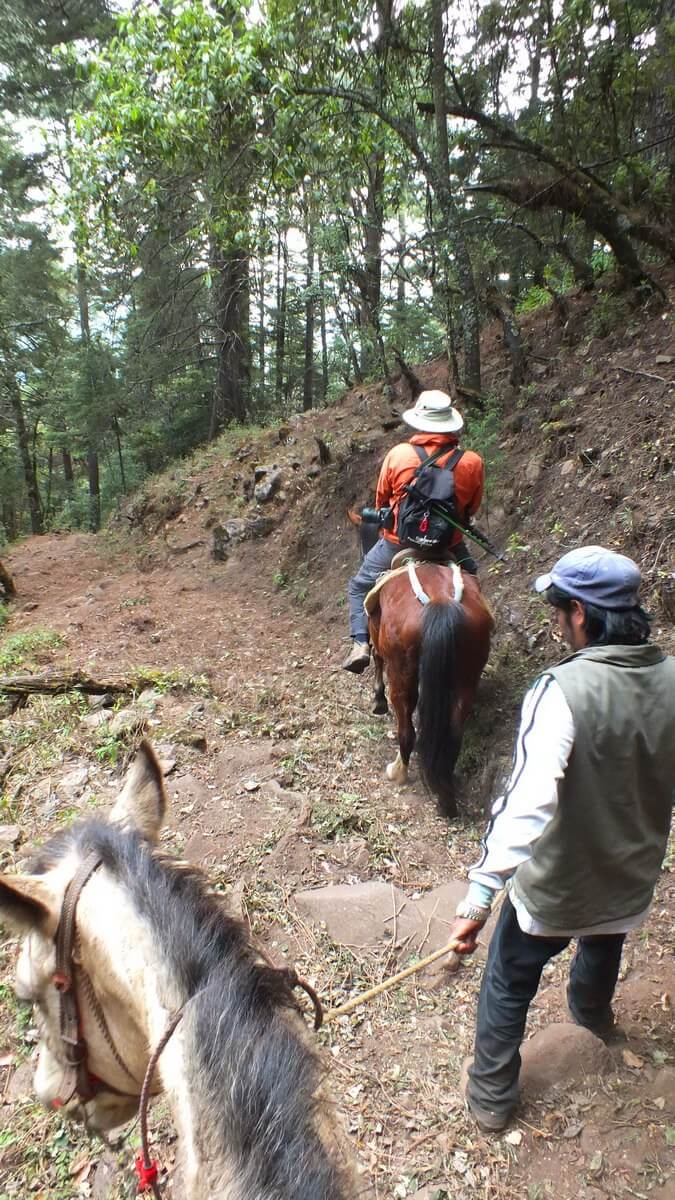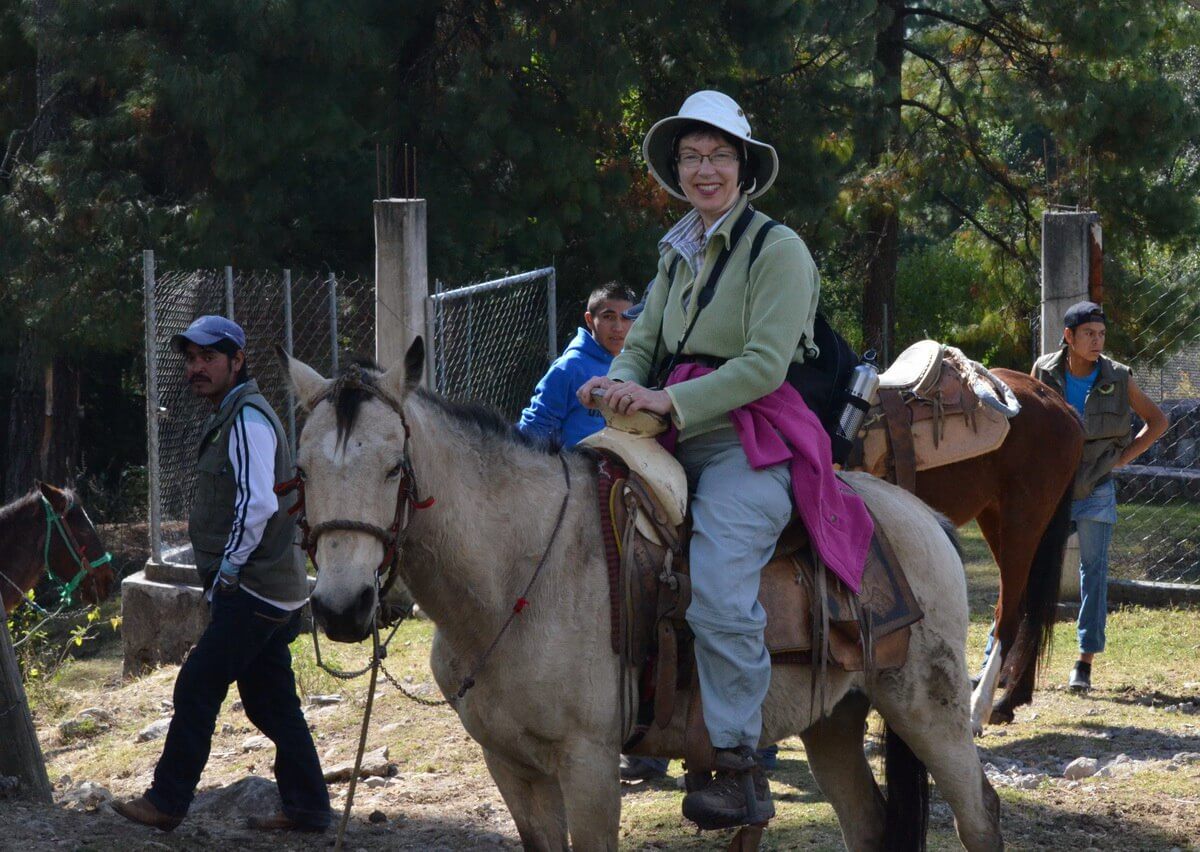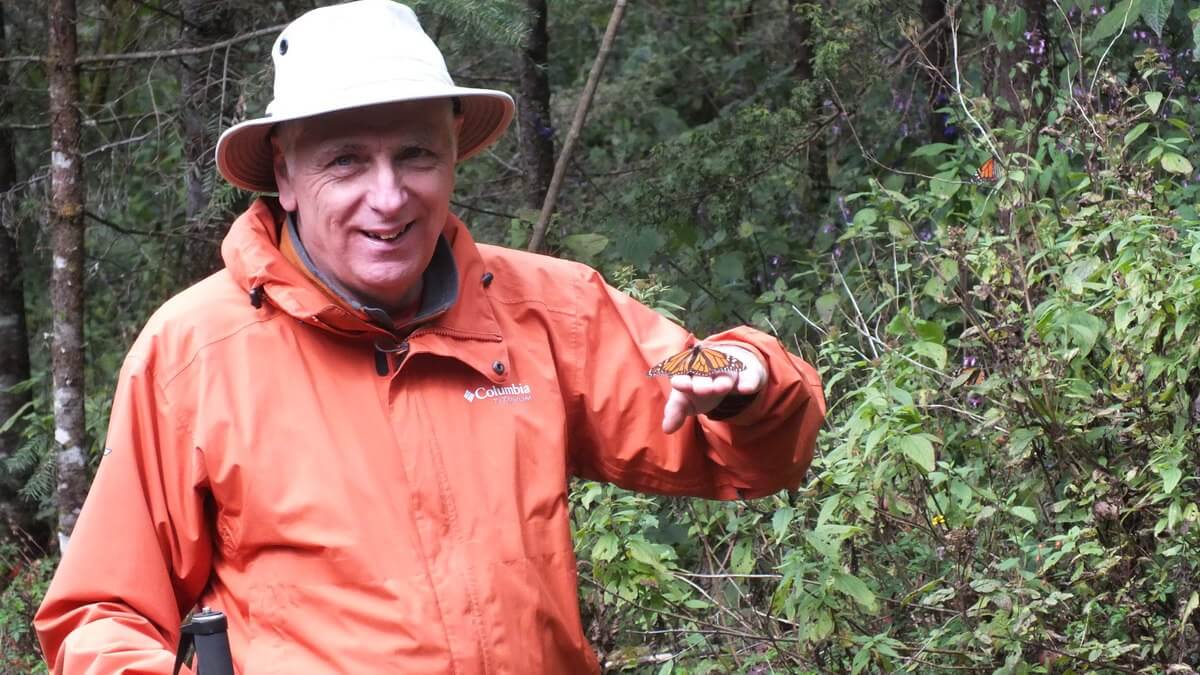Visiting Cerro Pelon Monarch Butterfly Sanctuary on Horseback

Even before we left Canada for Mexico, Bob and I had planned to visit all three of the monarch butterfly sanctuaries that are near Zitacuaro. Pablo, the host at our hotel, Hotel Rancho San Cayetano, was very pleased that we included Cerro Pelon Monarch Butterfly Sanctuary in our plans. Of the three that we would visit, Cerro Pelon is the least known and hence less visited, two pluses in our book, but perhaps it is for good reason. To reach the roosting location of the butterflies, riding on horseback is almost a necessity. It made for quite the adventure.
There are three access points to Cerro Pelon Monarch Butterfly Sanctuary, but the one we used, Macheros, was about a 40-minute drive from our accommodations. Bob and I closely followed the directions on a hand-drawn map that led us southeast into a valley surrounded by high mountains. We literally had to count the number of speed bumps or topes after turning from a traffic circle in Zitacuaro until we took a slight turn left onto a road towards the border of the State of Mexico. Soon, we found a huge sign pointing the way to the sanctuary’s staging area located in the pueblo of Macheros.
The day had started out blissfully sunny, but by the time we rode to higher altitudes, intermittent clouds had the temperature dropping and the Monarch Butterflies clinging to the trees for warmth. Thankfully, temporary breaks in the cumulus clouds cast enough light on the resting butterflies for decent pictures and warmed the Monarchs into action.
Our expedition would see us climbing from the mountain valley into the high altitude tropical forests that grow up the sides of Cerro Pelon mountain, one in the Sierra Madre mountain range.
A low, red brick building in the staging area at Cerro Pelon Monarch Butterfly Sanctuary housed a modest museum, washrooms and around the back a ticket booth where visitors decided whether to opt for a horse or to go on foot. Pablo had warned us that the ascent would be very challenging, so we had previously decided to hire horses and a guide but more for the experience since we had hiked to two other butterfly sanctuaries already.
Numerous mounts were available for hire, and staff carefully selected a horse to suit my size with stirrup leathers that were adjustable to the length of my legs. In moments, I was in the saddle and raring to go. Because Bob is tall, it took a little more effort to suit him up, but we were pleased with our chosen steeds and couldn’t wait to get underway.
The trail initially looked like an old dirt road that entered the forest a stone’s throw from the corral. I was grateful for the fairly even and level surface until I could adjust to my horse’s gait and gain some confidence in the saddle. I had ever only been on a horse once before, on a Mother’s Day outing with my family, and let’s just say that the terrain on that ride did not compare with what we were about to tackle.
Bob was given control of his horse so was in the lead, while our guide led my mare and brought up the rear. In no time, the trail became an uphill slant, but I was firmly rooted in my seat and even able to manage operating my camera with one hand for a few attempts to capture the moment.
The temperature was on the cool side once under the forest canopy given that the blue sky saw a procession of ever more frequent clouds, but we were dressed in layers and the exertion of riding the horses kept us comfortably warm.
The further from the trailhead that we traveled made Bob and I realize how glad we were to have hired a guide given the number of intersecting trails that were cut through the forest. As we advanced, the path became very narrow, extremely rocky, exceptionally steep and downright dusty.
Having forested slopes on either side gave me some sense of security…I wasn’t going to fall off a cliff or something… but some tight corners had my knees and ankles bumping tree trunks or my stirrups etching evidence of my passage into the rocks. On horseback, the trek took two hours, and given the condition of the trail in most sections, I could see that to hike it would have taken an awful lot longer and aggravated my knees. There are no photos of any difficult sections because I was hanging on for dear life.
Dappled sunlight filtered through the towering pine and fir trees as we wound our way along the sinuous trail; our quest would take us to an altitude of over 3,000 metres (10,000 ft). When the trail edged close to a steep slope and the trees opened up to reveal a spectacular view of the valley and lowland below, our progress became more tangible.
My saddle seemed to want to list to the left, and to fall off the horse would have guaranteed serious injury on the endless piles of loose boulders and rocks, so I quickly established the habit of keeping my heels down and my knees pinched together. I was white-knuckling it on the plate-sized horn but did manage to operate my camera a few times, with one hand mind you, and at one point, even tried videotaping Bob as he negotiated some of the more risky vertical climbs. Suffice it to say that the recording was useless because my horse never slowed, my bouncing was non-stop.
And then it happened. A small holding area for the horses marked the end of our ride. The mounts were restricted to a cordoned-off area some 15 minutes away from the present roosting location of the butterflies, and already there were four other horses loosely tied to slim tree trunks around the shaded edge of the clearing. I was happy to dismount, but it took a couple of minutes for me to work out my creaky knees. I was hobbling around like some old cowpoke.
The furrows from runoff stood for the path that twisted upwards into the undergrowth, and already glimpses of what lay ahead dotted the sky like bits of coloured tissue paper.
For about two hours, Bob and I wandered thin paths on the mountainside for a change of perspective on the roosting colony of Monarch Butterflies. A couple visiting from Ottawa, Canada, recounted their visit to Cerro Pelon a day earlier when the sun’s rays were stronger, and that day, millions of butterflies filled the sky. It was easy to see why the butterflies were less active the day of our visit. Chilly fingers crept up my back with every intermittent cool breeze that swept through the air.
As we kibitzed quietly with fellow butterfly enthusiasts, sudden bouts of sunshine encouraged the Monarchs to brave the frigid air and venture out in search of water.
We fervently wished that things would warm up. Even Bob and I had to zip up all layers of our clothing to stave off the damp cold of the cloud forest. We couldn’t imagine being a delicate butterfly with gossamer wings tossed by the breeze as it moved the branches aside.
We were keen to follow our guide on any possible track that would remove ourselves from the small group of observers. It was important to us to foster our own private experience with the Monarchs.
One particular burst of sunshine lit up the forest revealing tight groupings of butterflies on the oyamel fir branches. Squeezed together for warmth, the braver butterflies now dared to venture forth. As the number of airborne grew, their rustling wings murmured through the cathedral of trees like an angel’s chorus.
But every subsequent breeze had them scattering through the air to the protection of the leafy branches. Their retreat was quick and complete. Unless the Monarch Butterflies are adequately warmed by solar energy, they will not have the necessary strength to return to the trees as the afternoon temperature dips. Frost on the mountain is a daily nighttime risk, and the dense clusters of butterflies serve to stave off death.
As it was, hundreds of dead Monarchs lay amongst the forest litter having succumbed already to the rigors of biting winds, freezing temperatures, and a thin canopy. Bob and I were very surprised to see such a loss of life because at the two previous butterfly sanctuaries, El Rosario and Sierra Chincua, only a few carcasses lay about.
We wonder at the marvel of these lustrous creatures that make such an astonishing journey only to fall prey to the vagaries of an uncertain climate, but that is one of the amazing aspects of Cerro Pelon…the way it imparts the sheer recklessness of nature.
I was determined to find a tagged butterfly so searched among those bodies laying on the ground as well as the butterflies hovering on plants in the underbrush. You would think with all the millions of Monarchs on site, it would be possible to find just one with a numbered sticker on its wing, but no such luck. Only for one of the guardians at the colony, who had come across a single dead butterfly with a tag, we would have been denied the pleasure.
I’ve got to tell you that I was downright excited to at least see one Monarch with a tiny, paper ID tag. Different types of tags are used, but in every case, the information found on one reveals where the Monarch was tagged, and when properly reported, can provide information about the distance traveled by that certain butterfly and geographic features that may have been encountered along the migratory path.
Bob and I had gone in search of Monarch Butterfly caterpillars this past September at Tommy Thompson Park in Toronto, Ontario, and were encouraged by what we found. The numbers of larvae were up from the previous year, and there at Cerro Pelon Monarch Butterfly Sanctuary, I was thankful for the slight rebound in the overall Monarch Butterfly population.
Enormous clusters of Monarchs wove an orange tapestry through the soaring fir trees. With some bunches over a foot (30 cm) thick, all we could do was stand and stare.
We asked permission to eat our picnic lunch there beneath the butterfly-laden trees before setting off on horseback for the downhill run. It was already 2 o’clock. We gave 4 neatly-packed slices of fruit bread to our guide and two other guardians of the site who were required to stay on the mountain until all tourists left at the end of the day. They were grateful having hiked up the 5 kilometres of hilly terrain with neither water nor food.
A rough fallen log made the perfect place to sit and observe the Monarchs that glided down to land on low bushes and flowers. In order to keep warm, their wings were in a state of constant vibration.
Perhaps attracted by the sweetness of our fruit, one Monarch Butterfly lit on Bob’s hand. Like nature’s star that it is, the fanciful winged creature flew down from the heavens and graced him with a caress.
There are many lessons to be learned from the diminutive Monarch Butterfly. One must be resilient when reaching for your goals. There is strength even in fragility. Standing together makes one stronger when facing overwhelming odds. and, Our inner voice can surely guide us along the right path. All of these thoughts consumed me as I contemplated the butterflies in awe.
The ride back down the mountain at the Cerro Pelon Monarch Butterfly Sanctuary was grueling with the horse pitching me forward in the saddle every time it plopped down a steep drop in the trail’s surface or turned a sharp corner, and the trail was fraught with those conditions. My body absorbed the rocking flow of the horse’s movement, but still I had my heels pushed deep and my legs firmly extended to maintain tension in the stirrups. My horse grew anxious as it neared the end of the trail and tried to lurch ahead, so for once, I was grateful to be eating dust all day. Bob’s horse blocked the way. By the time we dismounted, both Bob and I were exhausted and lame, but the adventure had been well worth it. I would do it all over again.
Frame To Frame – Bob and Jean
































Bob could you please put my friend Willa on your mailing list. She is the widow of Bob Mclean of CBC fame….a guy I worked with in Barrie many years ago. Thanks we both love the material you and Jean send out.
Bill Harrington
While do Bill. Always good to hear from you. And I like you have fond memories from my days working in Barrie. Jean and I also love your Facebook postings. Bob & Jean